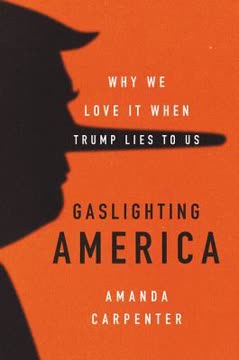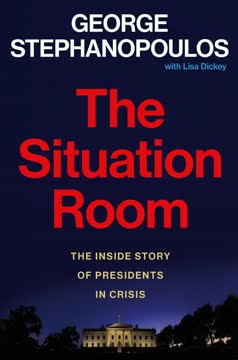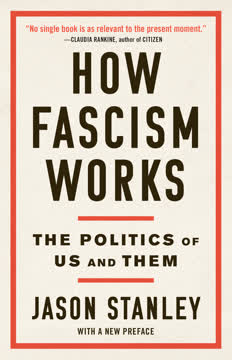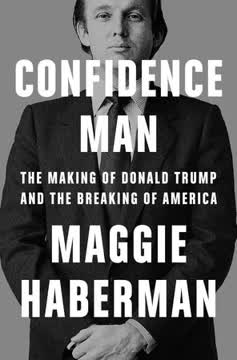Key Takeaways
1. Trump's Gaslighting: A Five-Step Method of Political Manipulation
Donald J. Trump is president, but he’s also a professional gaslighter.
Defining Gaslighting. Gaslighting is a psychological manipulation tactic where a person lies so brazenly that others begin to question their own reality. The author, having witnessed the 2016 election firsthand, realized Trump employed a methodical, five-step process honed from his tabloid days to control narratives and people. This method is far more aggressive than simple political lies, aiming to make targets feel "crazy" and disoriented.
The Five Steps. Trump's gaslighting method is a deliberate, calculated strategy to dominate the political landscape.
- Stake a Claim: Identify a risky but high-potential political issue no competitor would touch, ensuring a media frenzy.
- Advance and Deny: Introduce the issue to the public by raising questions or discussing what "others are saying," avoiding direct responsibility.
- Create Suspense: Promise forthcoming evidence or revelations, keeping the media and public in constant anticipation.
- Discredit the Opponent: Attack the motives and character of critics who gain traction, shifting blame and focus.
- Win: Declare victory regardless of circumstances, often by reframing the outcome or dismissing opposition as "losers."
A Textbook Example. Trump's birtherism campaign against Barack Obama perfectly illustrated this method. He staked a claim on a fringe conspiracy, advanced it by "just asking questions," created suspense with promises of "soon-to-be-produced" evidence, discredited Obama for being "distracted," and ultimately declared victory by claiming he "finished it." This pattern, the author argues, is the true secret to Trump's political success, not merely his "art of the deal."
2. Exploiting a Disillusioned Base: The Rise of Anti-Establishment Politics
Winning and beating liberalism sound similar, yet they each create a totally different appetite for the kind of Republican candidate voters would choose to represent them.
A New Appetite. After two consecutive presidential losses with "electable" candidates like John McCain and Mitt Romney, Republican voters in 2016 were no longer just seeking to "win"; their primary goal was to "beat liberalism." This shift in appetite meant they were open to a candidate willing to fight dirty, even if it meant abandoning traditional Republican principles or civility. The Democrats' aggressive tactics in previous elections, including personal attacks and accusations of bigotry, had pushed conservatives to a breaking point.
The "Winning Ugly" Mandate. Republicans felt they had "played nice" and lost, leading to a desire for a candidate who would "get ugly back." This sentiment was fueled by:
- Democratic Smears: Accusations of racism for opposing Obamacare or advocating border control.
- Cultural Warfare: Demands for rapid acceptance of gay marriage and transgenderism, perceived as threats to religious freedom.
- Ignoring Concerns: Mainstream media's dismissal of conservative outrage over issues like the Kermit Gosnell abortion clinic or government scandals.
This environment created fertile ground for a candidate who promised to fight without restraint.
The Rise of Conservative Media. During the Obama years, a new ecosystem of right-wing media flourished, including Breitbart News, The Federalist, and The Daily Caller. These outlets catered to a conservative audience, providing:
- Alternative Narratives: Detailed coverage of scandals ignored by mainstream media (Solyndra, Fast and Furious, VA wait lists).
- Anti-Establishment Messaging: Constant reminders that "liberals running the government and the media can’t be trusted."
- Direct Engagement: Platforms for provocateurs like James O'Keefe, turning the tables on "political correctness."
This media landscape fostered deep distrust in mainstream sources, making voters susceptible to figures like Alex Jones and his conspiracy theories, as seen with the Jade Helm panic.
3. Weaponizing Smears: How Trump Dismantled His GOP Rivals
Trump wasn’t going to let Jeb Bush run on his record as a Florida governor. He would make him run on his brother’s presidential record, which was deeply scarred by the politics of war.
Targeting Jeb Bush. Trump's first major gaslighting target was Jeb Bush, the presumptive front-runner, who represented the "Republican-in-name-only" establishment. Trump's strategy was to force Bush into an inescapable psychological box, defining him by his family's perceived weaknesses rather than his own record. This began with a "test run" attacking Bush's Mexican-born wife, then escalated to blaming George W. Bush for 9/11, a fringe conspiracy that united far-left and far-right sentiments.
The 9/11 Gambit. Trump's accusation that "The World Trade Center came down during your brother’s reign" was a calculated move to:
- Stake a Claim: Enter politically toxic territory no other candidate dared touch.
- Advance and Deny: Blame Bush for 9/11 while simultaneously denying direct blame, creating ambiguity.
- Create Suspense: Hint at "secret papers" that would reveal the "real" culprits (the Saudis), fueling conspiracy theories.
- Discredit Bush: Force Bush to defend his family's legacy, highlighting his "Bush" identity and the unpopular Iraq War.
This tactic successfully "finished off" Bush's campaign, proving Trump's gaslighting effectiveness.
Defeating Rubio and Cruz. Trump applied similar tactics to other rivals:
- Marco Rubio: Labeled "Little Marco," leading to a crude exchange about hand size that made Rubio appear undignified.
- Ted Cruz: Branded "Lyin' Ted," with attacks including renewed birtherism claims (despite Cruz's U.S. citizenship) and the outlandish conspiracy that Cruz's father was linked to JFK's assassination.
These relentless, often baseless, attacks forced opponents into defensive postures, making them appear weak or unhinged, while Trump's supporters cheered his willingness to "fight."
4. The Surrogate Army: Amplifying Lies and Deflecting Truth
Keeping up the lies is a sign of loyalty to Trump—proof that one is fully devoted to him.
Unconventional Loyalty. Trump cultivated an army of allies, largely "Tea Party misfits and other striving activists," who were eager for attention and had little to lose by associating with him. These surrogates, often unpaid, became crucial in obscuring Trump's chronic lying. Their loyalty was absolute, characterized by:
- Compulsory Deification: Using superlatives like "incredible" and "phenomenal" to praise Trump, even for family members and his physician.
- Lack of Shame: A universal willingness to defend even the most "fetid of Trump's fake narratives," viewing it as a "litmus test" of loyalty.
- "No Halfway" Trumpism: As Newt Gingrich explained, allies had to be "110 percent" with Trump or risk being "destroyed altogether."
Rhetorical Tricks of the Trade. Trump's surrogates employed a range of tactics to defend him and spread his gaslighting:
- Whataboutism: Answering criticism with counter-accusations (e.g., "Donald Trump may be vulgar, but Hillary Clinton is a two-faced liar").
- Anti-Anti-Trumpism: Attacking those who criticized Trump, even if it meant abandoning conservative values.
- Trumpsplaining: Claiming only Trump sympathizers could properly interpret his statements, dismissing critics as "elites."
- Figuratively, Not Literally: Arguing that Trump's supporters understood his "heart" and "seriously" believed him, even if his words were not "literally" true.
- Play Pretend: Denying Trump said something or reinterpreting his words to be innocuous (e.g., "Second Amendment people" filing amicus briefs).
- Play Dumb: Feigning ignorance to burn up airtime and avoid addressing difficult questions.
- Conversation Kamikaze: Derailing discussions with provocative, often offensive, historical parallels or personal attacks.
- Sore Loserism: Dismissing any criticism as a refusal to accept Trump's victory.
- Nondenial Denial: Appearing to deny an allegation without actually doing so, often for legal protection.
- Not Hillary: The ultimate fallback, reminding Republicans that Trump achieved the momentous task of defeating Hillary Clinton.
The Cost of Loyalty. This unwavering defense, even in the face of blatant falsehoods (like Melania Trump's plagiarized speech), meant that Trump's allies often looked foolish or unethical. However, for many, the boost in profile and perceived proximity to power outweighed any reputational damage, demonstrating the powerful incentives within Trump's gaslighting ecosystem.
5. "Fake News" and Kayfabe: Manipulating Media and Reality
The true purpose was to provide cover for boycotting the Fox News debate.
War on the Media. Trump's gaslighting extended to the entire American media complex, culminating in his branding of critical outlets as "fake news." This strategy began with his attacks on Megyn Kelly, whom he typecast as a "moody bimbo" for asking tough questions. By boycotting a Fox News debate and hosting a "veterans fundraiser" instead, Trump gaslit the network into believing he didn't need them, ultimately gaining control over a major conservative media outlet.
The Rise of Actual Fake News. The 2016 election saw an explosion of fabricated news stories, often mimicking legitimate outlets, designed to generate clicks and revenue. These stories, like "I Was Paid $3,500 to Protest Trump's Rally," went viral, especially among Trump supporters who were already primed to distrust mainstream media. This phenomenon was exacerbated by:
- Social Media Dominance: 62% of Americans got news from social media in 2016, platforms with "zero editorial accountability."
- Confirmation Bias: Fake news often confirmed existing political worldviews, making it readily accepted.
- Emotional Arousal: Stories that provoked awe or anger were more likely to be shared, regardless of factual accuracy.
Kayfabe and Conspiracy. Trump expertly tapped into America's "paranoid style in American politics," leveraging long-standing conspiracy theories about Hillary Clinton (body count, health, secret email server). His embrace of figures like Alex Jones, who peddled outlandish claims (e.g., Clinton and Obama "smell like sulfur"), introduced a concept akin to "kayfabe" from professional wrestling.
- Kayfabe: An "unspoken contract between wrestlers and spectators" where something "clearly fake" is presented as "real," eliciting "genuine emotion."
- Emotional Fidelity: For many Trump supporters, feelings became "inherently more trustworthy than facts," allowing them to "believe so" even if they didn't "think so."
This blurring of lines between reality and performance allowed Trump to push narratives that resonated emotionally, regardless of their factual basis.
6. Russian Meddling: A Strategic Alliance with Trump's Narrative
No one needs to prove any kind of criminal collusion to see how Trump’s arguments and the Russian hacking complemented each other.
WikiLeaks and DNC Hacks. Days before the Democratic National Convention in July 2016, Russian hackers, via WikiLeaks, released thousands of DNC emails. This "political bombshell" revealed DNC operatives disparaging Bernie Sanders, causing chaos and leading to the resignation of DNC chair Debbie Wasserman Schultz. Trump immediately seized on this, using it to amplify his existing "rigged system" narrative, claiming the emails proved the election was unfair to Sanders.
Trump's Call to Russia. Trump's gaslighting of the DNC hacks followed his established method:
- Stake a Claim: He took ownership of the WikiLeaks narrative, framing it as proof of a rigged system.
- Advance and Deny: He amplified the story while denying any personal involvement or benefit from Russian hacking, even suggesting it could be "China, or it could be somebody sitting in his bed."
- Create Suspense: Unthinkably, he openly called on Russia to find Hillary Clinton's "30,000 missing e-mails," creating immense media frenzy and keeping the email scandal alive.
- Discredit Clinton: He used the emails to insist the election was rigged for Clinton, portraying her as corrupt and undeserving.
Russian Disinformation. The U.S. intelligence community concluded that Russia's influence campaign aimed to undermine faith in American democracy and harm Clinton's electability. Russian state-funded media like RT and Sputnik consistently portrayed Trump as a victim of unfair media and a corrupt establishment.
- "Messaging Strategy": Blending "covert intelligence operations" with "overt efforts by Russian government agencies, state-funded media, third-party intermediaries, and paid social media users or 'trolls.'"
- Fake Stories: Spreading false narratives, such as a U.S. airbase in Turkey being overrun by terrorists, which even infiltrated the Trump campaign (Paul Manafort repeated it).
The synergy between Trump's gaslighting and Russian disinformation created a powerful, mutually reinforcing narrative that sowed distrust and benefited his campaign.
7. The Clinton Conspiracypocalypse: A Masterclass in Gaslighting
The real lesson that Trump, and every other politician who studied the situation, could learn is that full-on denial of reality works when expressed with enough confidence.
The "Bimbo Eruptions" Playbook. The Clintons themselves had a history of gaslighting, particularly in dealing with Bill Clinton's sexual misconduct allegations. They employed "full-on denial of reality" and attacked accusers, successfully portraying Monica Lewinsky as a "narcissistic loony toon" and "unstable stalker." This reactive gaslighting, though effective in preserving Bill's presidency, came at the cost of the women involved and, arguably, the integrity of liberal feminism.
Trump's Proactive Weaponization. Trump, however, took this tactic to a new level, using it proactively against Hillary Clinton. He resurrected the "bimbo eruptions" to undermine her strongest claim to the White House: being a champion for women.
- Instagram Videos: Early in the campaign, Trump released videos juxtaposing Bill Clinton's accusers with Hillary's "women's rights" rhetoric.
- "Enabler" Narrative: Trump argued Hillary was "not a victim" but an "enabler" who "bullied, attacked, shamed and intimidated his victims."
- Debate Spectacle: Before the second presidential debate, Trump held a press conference with Bill Clinton's accusers, then used the debate stage to directly accuse Hillary of "viciously" attacking them.
"Lock Her Up" and the Comey Bomb. Trump's gaslighting culminated in the "Lock Her Up" narrative, fueled by the FBI's re-opening of the investigation into Clinton's emails just eleven days before the election. This created a "conspiracypocalypse" for Clinton, as Trump, fake news, Russian hackers, and the alt-right simultaneously intensified their efforts to discredit her.
- FBI Investigation: The discovery of Clinton emails on Anthony Weiner's laptop provided a "gift-wrapped" opportunity for Trump.
- "Corrupt Hillary": Trump relentlessly hammered the message that Clinton was "corrupt," "the devil," and deserved to be jailed.
- Victory: Clinton's strategy of stoicism failed; Trump's relentless gaslighting, combined with external factors, led to his shocking victory.
8. Presidential Gaslighting: The Continuation of a Winning Strategy
Feelings, not facts, are essential to a good gaslighting.
No Pivot to "Presidential." Despite promises to be "so presidential," Trump continued his gaslighting methods as president, now with the full machinery of government at his disposal. His post-election claim of winning the popular vote "if you deduct the millions of people who voted illegally" set the tone, demonstrating his reliance on "feelings, not facts."
Early Presidential Gaslighting:
- Voter Fraud Commission: Trump established a handpicked commission to investigate his unsubstantiated claims of illegal voting, creating suspense, only to dissolve it later, blaming "Democrat States" for obstruction and claiming victory.
- Inauguration Crowd Size: On his first day, Trump falsely claimed his inauguration had "the largest audience to witness an inauguration—period." His press secretary, Sean Spicer, was forced to defend this with "alternative facts," a term that became emblematic of the administration's approach to truth.
The Comey Firing and "Witch Hunt." Trump's most significant act of presidential gaslighting was the abrupt firing of FBI Director James Comey amidst the Russia investigation.
- New Narrative: Trump aimed to turn Comey into the "figurative poster boy of the Deep State," a villain to offset the Russia collusion narrative.
- Advance and Deny: He simultaneously claimed he fired Comey due to the Russia investigation while denying anything substantive to it, calling it a "made-up story."
- Suspense and Discrediting: Trump tweeted about potential "tapes" of their conversations, then branded Comey a "leaker," successfully discrediting him and rallying supporters against the "nefarious Washington culture."
This strategy allowed Trump to control the narrative, convincing his base that the "real crimes" were being committed by those investigating him, turning reality on its head.
9. Nixon's Shadow: Historical Parallels in Power and Deception
Just as Nixon had his plumbers, Trump has his firemen, who are all too eager to assist in his gaslighting of America.
Shared Traits of Scandal. The author draws striking parallels between Trump and Richard Nixon, beyond just the "Watergate" controversy. Both presidents shared a "toxic triad" of qualities that led to scandal:
- Deep Resentment of the Press: Both rallied their bases against the media, with Nixon calling his supporters the "silent majority" and Trump the "forgotten man."
- Hatred of Government Leaks: Nixon's "plumbers unit" was formed to hunt down leakers, leading directly to Watergate. Trump's "leaker" narrative against Comey mirrored this.
- Aides Blindly Doing Their Bidding: Both inspired aides to "cast aside integrity to please the president," justifying unthinkable acts in the name of loyalty.
The Martha Mitchell Effect. Nixon's White House engaged in gaslighting tactics against Martha Mitchell, wife of Attorney General John Mitchell. When she tried to warn reporters about wrongdoing, Nixon's aides:
- Quarantined Her: Kept her under close watch, preventing her from speaking to the press.
- Discredited Her: Hinted she was "hallucinating," "deranged," or "just drunk," even drugging her.
This "Martha Mitchell effect" describes how individuals who correctly report improbable events are judged to be deluded. Nixon, even after his resignation, continued to blame Martha for Watergate, demonstrating his unwavering commitment to gaslighting.
The Cost of Gaslighting. Nixon's "third-rate burglary" ultimately led to sixty-nine charges, forty-eight guilty pleas, and his resignation. Despite winning a landslide re-election in 1972 by denying wrongdoing, his legacy remains one of disgrace. The author suggests that Trump, like Nixon, may face similar consequences for his "irrational measures" and gaslighting, highlighting the dangers when presidential power is used to manipulate truth.
10. Fireproofing America: Strategies for Navigating a Gaslit Political Landscape
Let go of the outrage already. It’s too exhausting to keep up and it plays right into Trump’s (imaginarily large) hands anyhow.
Coping with Gaslighting. Since Trump's gaslighting is a "permanent fixture" that "cannot be stopped," individuals must adapt to stay sane. The key is to disengage from the emotional manipulation and critically analyze his methods:
- Question the Objective: When Trump floats a new narrative, ask "Why is he focusing on this?" The stated message may not be the real one.
- Demand Sources: Challenge vague references to "what other people are saying" and pin him down on actual evidence.
- Tune Out the Hype: Resist the urge to endlessly speculate on his "advance-and-deny" stage, as this amplifies his message.
- Pressure for Proof: Force Trump to deliver on his promises of "forthcoming information," as he rarely does.
- Recognize Discrediting: Understand that his insults are strategic tests of loyalty and attempts to make you spread his message.
- Challenge "Winning" Claims: Question sources that declare Trump "vindicated" or "winning" despite setbacks, especially if they are invested in his success.
New Rules for Candidates. Future political candidates must also adapt to this "gaslit America":
- Talk and Act Like Real People: Abandon "message discipline" and artificiality for authenticity, relatability, and genuine communication.
- Talk Big, Sell the Dream: Focus on inspiring, inclusive visions rather than getting bogged down in policy details or self-congratulatory slogans.
- Fight Back (Strategically): Don't shy away from counter-punching against unfair attacks, but do so with well-placed jabs rather than all-out assaults.
- Control the Narrative: Proactively shape the media environment through strategic announcements, surprises, and direct communication, rather than letting mainstream media define the story.
The Falsifiability Test. To distinguish genuine concerns from conspiracy theories, apply the "falsifiability" test: "What evidence would prove this isn't true?" If the answer is "nothing," then disengage. The goal is to resist giving Trump more control than he already has, maintaining perspective, and refusing to be drawn into his "dizzying logic circles."
Last updated:
Review Summary
Gaslighting America receives mostly positive reviews for its insightful analysis of Trump's manipulation tactics. Readers appreciate Carpenter's breakdown of Trump's five-step gaslighting process and find it enlightening. Some praise her conservative perspective, while others find it distracting. The book is commended for its clear explanations and examples of Trump's behavior. Critics note Carpenter's partisan bias and lack of self-reflection on the Republican Party's role. Overall, readers find the book informative and valuable for understanding Trump's strategies, regardless of political affiliation.
Similar Books
Download PDF
Download EPUB
.epub digital book format is ideal for reading ebooks on phones, tablets, and e-readers.








